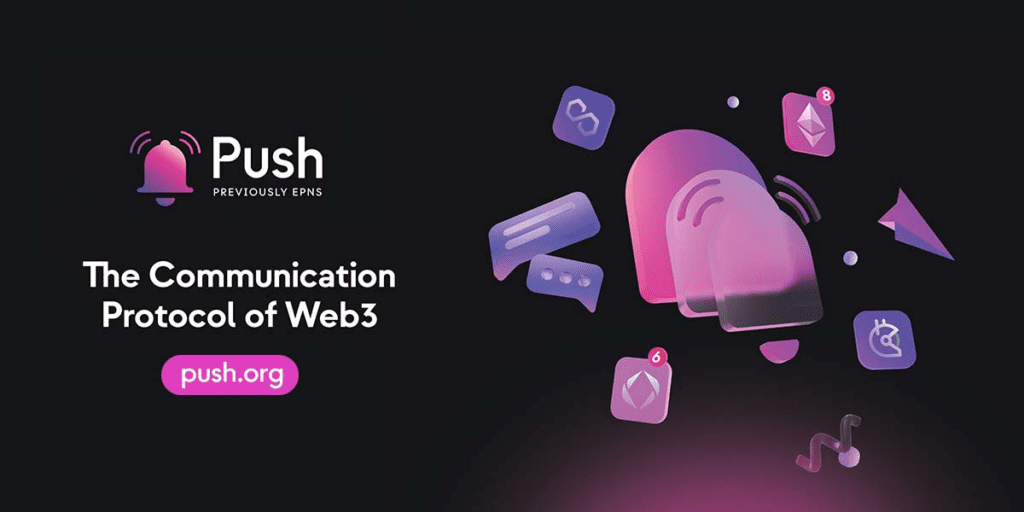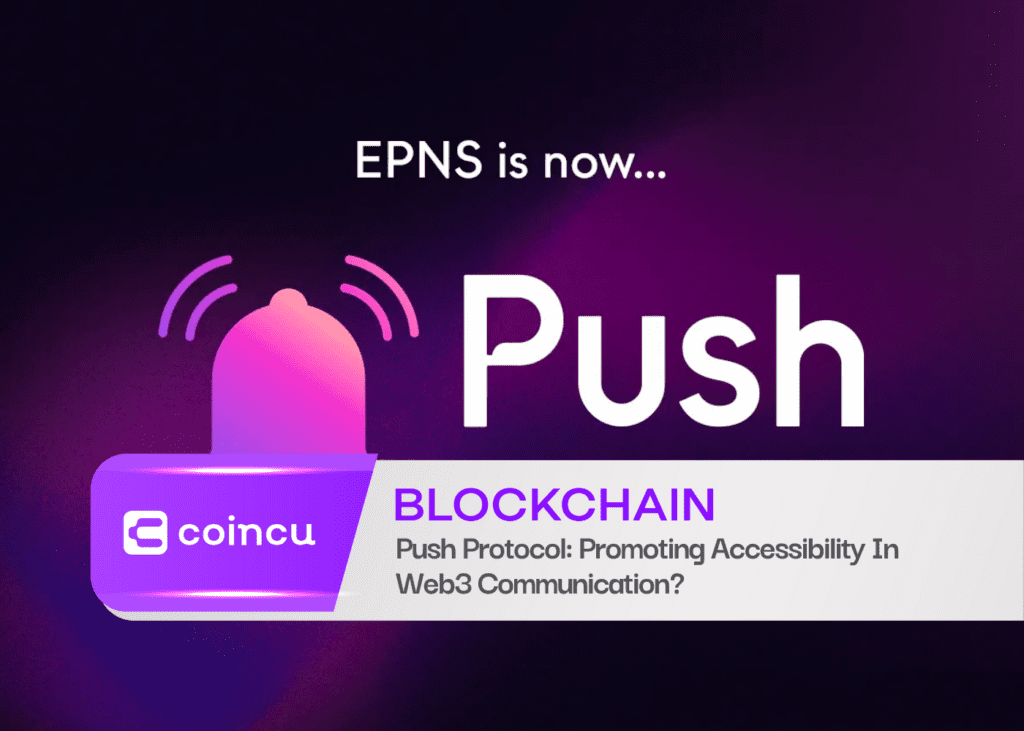Key Points:
- Push Protocol enables all dApps, smart contracts, backends, and protocols.
- After two years of development, Push Protocol has become the main project of the message push pipeline and has also become an important and indispensable infrastructure in the Web3 industry.
Push Protocol is a Web3 decentralized communication protocol that enables any smart contract, dApp, or even traditional service to send notifications to wallet addresses.

Overview
Push Protocol is a decentralized communication protocol for Web3, which enables any smart contract, dApp, or even traditional service to send notifications to wallet addresses, provided that these wallet addresses choose to receive messages from these channels, it can be applied to Web3. In the whole scene, including DeFi asset liquidation, ens domain name expiration, and media news push, etc., 17.7 million messages have been sent to 60,000 subscribers, which is the head project of the decentralized communication track.
Name and positioning Changes
Before September 2022, the name of PUSH was EPNS, which means “Ethereum Push Notification Service”. From the name, we can see that it was a project for Ethereum before that, and it positioned itself at that time It is a service rather than a protocol, so the old name is broken down into 3 parts: Ethereum, message notification and service, and the new name breaks these three parts.
As it starts to support other chains, such as Polygon, it will break through Ethereum to other L1 and L2. Secondly, the application scenarios are not limited to notifications but all message push scenarios. Finally, because it supports multiple chains and multiple scenarios, it is no longer a specific service but a protocol, so it continues to be called EPNS. It will limit its own business and brand, so it changed its name to Push Protocol.
Why a decentralized communication protocol is needed
Message push has been integrated into all aspects of traditional Web2, from IM chat to news, to various marketing information, notification prompts, etc. It is very mature in both application scenarios and technologies, but it is rarely useful in Web3 When it comes to dApps with message push capabilities, most of the requirements related to notifications are solved by email. The main reasons are:
- At present, most dApps are in the form of web pages on the PC side, and the development of the mobile terminal is extremely slow because the message push is instant, and the lack of the mobile terminal restricts the development of the message push scene. In contrast, Web2 was only widely used after the emergence of the mobile internet.
- The message push of the infrastructure layer of Web3 is indeed a development depression at present, and there are not many mature solutions that can be seen.
Even so, Web3 still has a large number of scenarios that require message push, such as DeFi price changes, voting result notifications, etc., and social protocol products such as Lens Protocol also integrate Push Protocol because the attention, likes, etc.
Comparison of Web2 and PUSH message push logic
Everyone’s mobile phone will receive a lot of messages from APPs every day, including friend messages from social software, headlines from news media, discounts from e-commerce platforms, etc. How are they realized? The following figure shows the process of the APP in the iPhone mobile phone sending messages to your mobile phone. The core is APNS (Apple Push Notification Service) as a transit service, which is divided into 3 stages:
- Phase 1: The upstream project party packages the message to be sent and the received iPhone ID and sends it to APNS.
- Phase 2: APNS searches for the iPhone with the corresponding logo in the list of iPhones registered for the Push service and sends the message to the iPhone.
- Phase 3: The iPhone passes the incoming message to the application and pops up the Push notification according to the settings.
The following figure shows the principle of Push Protocol. In fact, it will be found that the structure is consistent with APNS of Web2. The top three types of dapp, server and smart contract are in the input layer, that is, the source of message generation. After the message is passed into Push Protocol , the internal nodes will listen to the events in the protocol smart contract and forward the message to the corresponding receiver.
To put it simply, it can be understood that the contract, back-end service and other upstreams can bury a piece of EPNS code where message push is required, and pass in the corresponding message content, and Push Protocol will pass the message to the corresponding address. Of course, you must return There needs to be a front end in the downstream responsible for receiving and displaying messages.
As a protocol layer, Push Protocol is only responsible for the distribution process of messages. Of course, Push Protocol also makes a plug-in message box for the convenience of users. The messages received by users through Push Protocol will also be displayed.
The architecture of PUSH: users, channels, subscribers
There are three main concepts in Push Protocol: user, channel and subscriber.
- User: Refers to all entities in EPNS, including contracts, wallets, personnel, etc.
- Channel: The sender of the message is registered in the Push Protocol; the user needs to subscribe to the channel to receive the corresponding message
- Subscriber: the user who has subscribed
As shown in the figure below, when I open the Push Protocol operation console and click on the channels column, many channels will appear on the right side. These channels are the message senders created by the user.
I can choose to click to join and exit a certain channel. When I join, I need to sign up to become a subscriber of this channel. After signing, the messages generated in the channel will be sent to my wallet address. Users can unsubscribe at any time, so the user knows Absolute access to messages, no need to worry about being spammed, and the channel must bear the cost to send notifications, paid in ETH or DAI, which can also prevent the sending of spam messages to a certain extent.
We can see that the diversity of channels is very strong now; not only most of the mainstream Web3 products and protocols such as Snapshot, MakerDAO, etc. have settled in, but even serial novels have settled in, so the imagination space of Push Protocol application scenarios is still very large.
A pledge of 50 $PUSH is required to apply to become a channel, of which 10 $PUSH is used to create the agreement fee of the contract, and the rest of the Token will be stored in the contract pool of the channel owner, and the Token in the pool will be returned once the channel is deactivated.
Channels can send out 3 types of messages, broadcast notifications, clove notifications and subset notifications.
- Broadcast notification: send a message to all subscribers of the channel at once
- Directed notifications: can be sent to specific wallet addresses, provided they are subscribed to the channel, of course
- Subset notification: a variant of targeted notification that notifies a certain group of subscribers
How to integrate Push Protocol
Push Protocol supports sending messages through smart contracts, PUSH dApps, SDKs, etc. We take smart contracts as an example and first need to import the IPUSHCommInterface contract interface.
And define the address of the channel. Each channel created by a user will be assigned a channel address and then set as the receiving address. You can specify some subscription addresses, or you can directly set it to broadcast mode; that is, all subscribers will receive it.
In this way, when your contract code is executed to the corresponding position, you can complete the triggering of the message content once, and the nodes of the Push Protocol will transfer the content. After the message is sent, the downstream needs to receive and display the message. Push Protocol provides three receiving methods.
The format of the obtained message data is as follows, including message receiving address, message content, type and other information.
In addition, Push Protocol has also made its own Web3 native chat software, as shown in the figure below, which can realize the content sending of text, emoticons, and attachments, and this chat capability supports SDK integration, and any dapp can be connected to have a native Web3 chat Function.
Important future development direction
PUSH allows all dApps, smart contracts, backends, protocols, and even any distributed technology to communicate directly with the user’s wallet address. Currently, PUSH’s partners are involved in various important areas:
DeFi sends transaction-related information through PUSH: Decentralized financial activities have always been the main body of Web3. Scenarios that can use PUSH: Send some user education and learn about the latest developments and pools in the daily state; in an emergency state such as when a loan or collateral is close to liquidation, PUSH needs to be used to remind their users to take action; when participating in activities, users can be reminded about Changes in the prize pool, and the situation of winning, etc.
DAO organizations use PUSH for governance and voting: Decentralized autonomous organizations often need a large number of proposals, votes, and announcements in their daily lives. However, the current situation of using platforms such as Discord is that people will block or ignore important information. Using PUSH can end-to-end The terminal reminds users to participate in DAO governance.
GameFi uses PUSH for user incentives: players and the platform can communicate directly, and through PUSH, all NFT airdrops, rewards, and upgrade progress can be used as notifications to motivate users and encourage retention.
The data analysis protocol is combined with PUSH for more timely user notification: There are a large number of Web3 data analysis protocols on the market. By combining PUSH, users can directly customize their own needs, such as tracking the transaction volume of an NFT on an aggregated trading platform, reading SushiSwap’s Swap and pairing, notification when a certain nft floor price drops, etc.
All in all, PUSH may have a place in any important ToC field, such as the need to notify the progress in real-time when the legal agreement is signed, the downfall of the trading platform needs to be notified to the user as soon as possible, the results of the security contract audit can be broadcast directly to the community, and so on.
After two years of development, Push Protocol has become the head project of the message push track, and has also become an indispensable and important infrastructure in the Web3 industry. In the future, I hope to see PUSH develop in cross-chain end-to-end communication, and DAO builder will also help it flourish on the Web3 communication road.
DISCLAIMER: The Information on this website is provided as general market commentary and does not constitute investment advice. We encourage you to do your own research before investing.
Join us to keep track of news: https://linktr.ee/coincu
Harold
Coincu News





